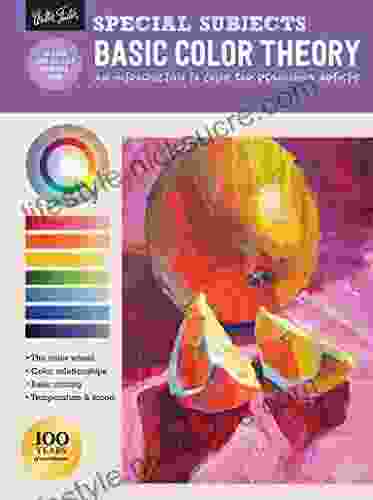An Introduction to Color for Beginning Artists: How to Draw and Paint Vibrant and Meaningful Masterpieces

Color is an essential element of art, bringing life, depth, and emotion to our creations. Whether you're a novice or an experienced artist, understanding the fundamentals of color can dramatically enhance your artwork. This comprehensive guide aims to introduce aspiring artists to the world of color and its transformative power in drawing and painting.
The Color Wheel: Your Essential Guide
The color wheel is a fundamental tool for artists, providing a visual representation of the relationships between colors. It consists of 12 hues: primary (red, blue, and yellow),secondary (green, orange, and purple),and tertiary (combinations of primary and secondary hues).
4.6 out of 5
| Language | : | English |
| File size | : | 33329 KB |
| Text-to-Speech | : | Enabled |
| Enhanced typesetting | : | Enabled |
| Print length | : | 40 pages |
| Screen Reader | : | Supported |
* Primary Colors: Red, blue, and yellow are the building blocks of all other colors. They cannot be created by mixing other colors and are the purest form of their respective hues. * Secondary Colors: Green (blue + yellow),orange (red + yellow),and purple (red + blue) are created by mixing two primary colors. * Tertiary Colors: Yellow-green, blue-green, red-orange, red-violet, blue-violet, and yellow-orange are obtained by mixing a primary and a secondary color.
Color Theory
Color theory explores the relationships and interactions between colors. Understanding these principles enables artists to create harmonious and impactful compositions.
* Complementary Colors: Colors that lie opposite each other on the color wheel (e.g., red and green, blue and orange) create a high contrast effect when placed side by side. * Analogous Colors: Colors that are adjacent to each other on the color wheel (e.g., blue, blue-green, and green) create a sense of unity and harmony. * Triadic Colors: Colors that are evenly spaced around the color wheel (e.g., red, yellow, and blue) produce a dynamic and lively composition. * Warm and Cool Colors: Warm colors (e.g., red, orange, and yellow) are associated with heat, passion, and energy, while cool colors (e.g., blue, green, and purple) are linked to calmness, tranquility, and depth.
Color in Drawing
Color can add depth and dimension to drawings, enhancing their visual appeal. When using colored pencils or markers, experiment with different shades and intensities to create shadows, highlights, and textures.
* Gradients: Create smooth transitions between colors by gradually blending them together. * Cross-Hatching: Use multiple layers of parallel lines in different colors to create depth and shading. * Stippling: Use small dots of color to build up areas of shade and highlight.
Color in Painting
In painting, the use of color is limitless. Artists can mix and blend paints to create a wide range of hues and values. Explore various techniques to create different effects:
* Washes: Dilute paint with water to create transparent layers of color that allow the underlying surface to show through. * Glazing: Apply thin layers of translucent paint over each other to build up depth and richness. * Impasto: Apply thick layers of paint with a palette knife or brush to create texture and movement. * Blending: Use a brush or sponge to blend colors together for seamless transitions.
Color and Symbolism
Beyond its visual impact, color can convey emotions, ideas, and cultural meanings. Artists can use color symbolism to enhance the narratives and messages conveyed in their artwork.
* Red: Associated with passion, excitement, danger, and love. * Blue: Linked to serenity, tranquility, trust, and spirituality. * Green: Represents nature, growth, prosperity, and envy. * Yellow: Symbolizes joy, optimism, intellect, and caution. * Black: Associated with mourning, mystery, authority, and sophistication.
Practical Color Exercise
To enhance your understanding of color, try this practical exercise:
1. Choose a subject to draw or paint (e.g., a landscape, a portrait, or a still life). 2. Identify the primary, secondary, and tertiary colors present in the subject. 3. Experiment with different color schemes (complementary, analogous, triadic) to create variations in your composition. 4. Use different techniques (washes, glazing, blending, etc.) to convey depth, texture, and lighting. 5. Explore the use of color symbolism to enhance the emotional impact of your artwork.
Tips for Aspiring Artists
* Familiarize yourself with the color wheel and color theory principles. * Practice mixing and blending colors to create a variety of hues and values. * Study the works of famous artists to observe how they use color to convey emotion and meaning. * Experiment with different color schemes and techniques to discover your own unique style. * Be patient and don't be afraid to make mistakes; color exploration is an ongoing journey.
Color is a powerful tool that can elevate your art to new heights. By understanding the fundamentals of the color wheel, color theory, and various color techniques, you can create vibrant and meaningful masterpieces. Embrace the transformative power of color and let it guide you on your artistic journey. Remember, color is not merely an addition to art; it is the catalyst that brings life, depth, and emotion to your creations.
4.6 out of 5
| Language | : | English |
| File size | : | 33329 KB |
| Text-to-Speech | : | Enabled |
| Enhanced typesetting | : | Enabled |
| Print length | : | 40 pages |
| Screen Reader | : | Supported |
Do you want to contribute by writing guest posts on this blog?
Please contact us and send us a resume of previous articles that you have written.
 Fiction
Fiction Non Fiction
Non Fiction Romance
Romance Mystery
Mystery Thriller
Thriller SciFi
SciFi Fantasy
Fantasy Horror
Horror Biography
Biography Selfhelp
Selfhelp Business
Business History
History Classics
Classics Poetry
Poetry Childrens
Childrens Young Adult
Young Adult Educational
Educational Cooking
Cooking Travel
Travel Lifestyle
Lifestyle Spirituality
Spirituality Health
Health Fitness
Fitness Technology
Technology Science
Science Arts
Arts Crafts
Crafts DIY
DIY Gardening
Gardening Petcare
Petcare Joseph Klaits
Joseph Klaits Hadley Wickham
Hadley Wickham Larry K Brendtro
Larry K Brendtro Dana Obleman
Dana Obleman Johan Norberg
Johan Norberg Adam Cort
Adam Cort Cody Monk
Cody Monk Ignatius Donnelly
Ignatius Donnelly Eric Tyndall
Eric Tyndall E T Bryant
E T Bryant Toni Tone
Toni Tone Tahlia Kirk
Tahlia Kirk Gerald Corey
Gerald Corey Mark Turley
Mark Turley Maria Youtman
Maria Youtman Michaela Riva Gaaserud
Michaela Riva Gaaserud Eugenia Viti
Eugenia Viti Amira Mikhail
Amira Mikhail Steven Charleston
Steven Charleston Stephen J Collier
Stephen J Collier Catherine Dees
Catherine Dees Helen E Fisher
Helen E Fisher Matthew Lombardi
Matthew Lombardi Patrick O Sullivan
Patrick O Sullivan The 60 Minutes Summary
The 60 Minutes Summary Rick Stanton
Rick Stanton Jack Freeman
Jack Freeman J L Weil
J L Weil Elise Christie
Elise Christie Jeanne Ryan
Jeanne Ryan Swede Burns
Swede Burns Joseph Wayne Smith
Joseph Wayne Smith Dr Bob Rotella
Dr Bob Rotella James Mullaney
James Mullaney Jack Ewing
Jack Ewing Lars Andersen
Lars Andersen Jason Thompson
Jason Thompson Kieron Gillen
Kieron Gillen Donovan Hohn
Donovan Hohn American Baseball Coaches Association
American Baseball Coaches Association Shannon O Bourne
Shannon O Bourne Douglas Wilson
Douglas Wilson Brittany Clair
Brittany Clair Amy Bizzarri
Amy Bizzarri Eugene C Toy
Eugene C Toy Robert W D Ball
Robert W D Ball Sarah J Maas
Sarah J Maas John Maxwell Wood
John Maxwell Wood Mark Worden
Mark Worden Tamora Pierce
Tamora Pierce Vicki Hearne
Vicki Hearne Pav Bryan
Pav Bryan Neville Goddard
Neville Goddard Shalabh Aggarwal
Shalabh Aggarwal Michael Ondaatje
Michael Ondaatje Amber Smith
Amber Smith Theresa Y Wee M D
Theresa Y Wee M D Angela Moore
Angela Moore Lady Antiva
Lady Antiva David Salsburg
David Salsburg Robert Melillo
Robert Melillo Jack Falla
Jack Falla Mike Adamick
Mike Adamick Amy Bleuel
Amy Bleuel Laini Taylor
Laini Taylor Krystal Sutherland
Krystal Sutherland Sian Warriner
Sian Warriner James E Packer
James E Packer John Jacobs
John Jacobs Michelle Newhart
Michelle Newhart Amir Alexander
Amir Alexander Donna Williams
Donna Williams Amy Mccready
Amy Mccready Tom Taulli
Tom Taulli Marshall Goldsmith
Marshall Goldsmith Kyle Hunt
Kyle Hunt K F Breene
K F Breene Autumn Jordon
Autumn Jordon Roman Gelperin
Roman Gelperin Theodore Sider
Theodore Sider Alex Stone
Alex Stone Meikang Qiu
Meikang Qiu Don Stradley
Don Stradley Test Masters
Test Masters Martin Williams
Martin Williams Derek Thompson
Derek Thompson Amara Charles
Amara Charles Amrita Pande
Amrita Pande Mitt Romney
Mitt Romney John L Field
John L Field Rachel Gurevich
Rachel Gurevich Joseph Conrad
Joseph Conrad Bethanne Kim
Bethanne Kim David Elkington
David Elkington Philip Gibson
Philip Gibson Deborah J Rumsey
Deborah J Rumsey Charles J Alsheimer
Charles J Alsheimer Sarah Woodbury
Sarah Woodbury Frederick Lenz
Frederick Lenz Marina Robb
Marina Robb Randy Schultz
Randy Schultz Steven C Hayes
Steven C Hayes Anthony Haynes
Anthony Haynes Charles Thompson
Charles Thompson Gia Giasullo
Gia Giasullo Summer Michaud Skog
Summer Michaud Skog Torey L Hayden
Torey L Hayden Kate Fox
Kate Fox Bridget Ericsson
Bridget Ericsson Jeff Gaudette
Jeff Gaudette Helena P Blavasky
Helena P Blavasky Kathy Spratt
Kathy Spratt Peter Larson
Peter Larson American Math Academy
American Math Academy Oscar Baechler
Oscar Baechler Devin Olsen
Devin Olsen Tom Patri
Tom Patri Therese A Rando
Therese A Rando Sharon K Zumbrunn
Sharon K Zumbrunn Kezia Endsley
Kezia Endsley Jayson Gaddis
Jayson Gaddis Stephenie Meyer
Stephenie Meyer Sterling Test Prep
Sterling Test Prep Jameson M Wetmore
Jameson M Wetmore Redmond O Hanlon
Redmond O Hanlon Brian Kateman
Brian Kateman Joseph Mcmoneagle
Joseph Mcmoneagle Jason Borte
Jason Borte David Yoon
David Yoon Sarah Morgan Haydock
Sarah Morgan Haydock Paul Schwartz
Paul Schwartz Jenny Landreth
Jenny Landreth Kathleen Glasgow
Kathleen Glasgow Rose Mannering
Rose Mannering Nikhil Bhardwaj
Nikhil Bhardwaj Sonia Hartl
Sonia Hartl Ruth M Tappen
Ruth M Tappen Chris Carlsson
Chris Carlsson Malba Tahan
Malba Tahan Julie Barlow
Julie Barlow Janet Engle
Janet Engle Julie Caplin
Julie Caplin Kevin Stiegelmaier
Kevin Stiegelmaier Kasie West
Kasie West Mac Fortner
Mac Fortner Howard J Meditz
Howard J Meditz Nikala Smith
Nikala Smith Laura Slinn
Laura Slinn Heidi J Larson
Heidi J Larson James P Kelly
James P Kelly Chris Irons
Chris Irons Alexandrea Weis
Alexandrea Weis Amy Brown
Amy Brown Edward J Denecke
Edward J Denecke Elizabeth S Gilbert
Elizabeth S Gilbert Rob Antoun
Rob Antoun Valerie Bass
Valerie Bass Frank Nappi
Frank Nappi Laurie A Watkins
Laurie A Watkins Dr Scott A Johnson
Dr Scott A Johnson Suzanne Stabile
Suzanne Stabile Henry A Zumbrun 2
Henry A Zumbrun 2 George Bernard Shaw
George Bernard Shaw Jim Santos
Jim Santos K M Shea
K M Shea Clotaire Rapaille
Clotaire Rapaille Christine Fanthome
Christine Fanthome Cookie O Gorman
Cookie O Gorman Rosalind Wiseman
Rosalind Wiseman Muhammad Vandestra
Muhammad Vandestra Jan Marie Mueller
Jan Marie Mueller Vince Kotchian
Vince Kotchian William Bohan
William Bohan Desi Northup
Desi Northup Nina Freudenberger
Nina Freudenberger Garrett M Fitzmaurice
Garrett M Fitzmaurice Ned Seaton
Ned Seaton Temple Grandin
Temple Grandin Michael Winkelman
Michael Winkelman Eric E Bowne
Eric E Bowne Gary Wiener
Gary Wiener Timothy Malcolm
Timothy Malcolm Dolores Kong
Dolores Kong Wendy Margolis
Wendy Margolis David Ranney
David Ranney Vivian Vande Velde
Vivian Vande Velde Norman Doidge
Norman Doidge Stephen Walker
Stephen Walker Kate Tietje
Kate Tietje Brendan Leonard
Brendan Leonard Ned Vizzini
Ned Vizzini Alex Polyakov
Alex Polyakov Buck Tilton
Buck Tilton L Frank Baum
L Frank Baum Claudia J Carr
Claudia J Carr Pamela Lynn
Pamela Lynn H Bedford Jones
H Bedford Jones Joel Cotton
Joel Cotton Jessica Cunsolo
Jessica Cunsolo Erin Chack
Erin Chack Richard Wagamese
Richard Wagamese Courtney Defeo
Courtney Defeo Joe Nickell
Joe Nickell Grant Dever
Grant Dever Shanna Cunning
Shanna Cunning Victoria Wood
Victoria Wood Denise Ni
Denise Ni Jeremy J Baumberg
Jeremy J Baumberg Paul Kockelman
Paul Kockelman Sandra T Barnes
Sandra T Barnes Lisa Maloney
Lisa Maloney Amy Perry
Amy Perry Thom Hartmann
Thom Hartmann Cheri Rae
Cheri Rae Erica T Lehrer
Erica T Lehrer Shere Hite
Shere Hite Ashley Scott
Ashley Scott Gal Dem
Gal Dem Gina Chen
Gina Chen Fred Pyrczak
Fred Pyrczak William Rosen
William Rosen Dima Zales
Dima Zales Eric Zweig
Eric Zweig Tavi Gevinson
Tavi Gevinson Liz Fosslien
Liz Fosslien J Stephen Jones
J Stephen Jones Amante P Marinas
Amante P Marinas Pico Iyer
Pico Iyer Traci Gormley
Traci Gormley Rick Deutsch
Rick Deutsch Amby Cooper
Amby Cooper Nathan Belofsky
Nathan Belofsky Jennifer Margulis
Jennifer Margulis Mariano Anaya
Mariano Anaya Jan E Stets
Jan E Stets Dan Abnett
Dan Abnett Jonathon Miller Weisberger
Jonathon Miller Weisberger Michael R Poll
Michael R Poll Peter Hayes
Peter Hayes Martin Pollizotto
Martin Pollizotto Anthony Horowitz
Anthony Horowitz American Psychological Association
American Psychological Association Doug Peterson
Doug Peterson Richard Cohen
Richard Cohen Robyn Davidson
Robyn Davidson Topher Donahue
Topher Donahue Byron Nelson
Byron Nelson Sue Monk Kidd
Sue Monk Kidd Benjamin Jelen
Benjamin Jelen Paul Graham
Paul Graham Ana And Jack Hicks
Ana And Jack Hicks Amber Zygutis
Amber Zygutis William Glasser M D
William Glasser M D Nisha Garg
Nisha Garg Jack Tupp
Jack Tupp Chad Ford
Chad Ford Christopher E Larsen
Christopher E Larsen Leslie Sansone
Leslie Sansone Amber O Neal Johnston
Amber O Neal Johnston Christopher Harlan
Christopher Harlan Derrick Jensen
Derrick Jensen Marit Weisenberg
Marit Weisenberg Robert A Weinberg
Robert A Weinberg Karen Deerwester
Karen Deerwester Josiah Hesse
Josiah Hesse Kristine Kathryn Rusch
Kristine Kathryn Rusch Jonathan Bartlett
Jonathan Bartlett Thomas J Whalen
Thomas J Whalen Emma Mae Jenkins
Emma Mae Jenkins Kathleen M Stacy
Kathleen M Stacy Jerry D Moore
Jerry D Moore Amy Blakeslee
Amy Blakeslee Silvia Botros
Silvia Botros Amber Lia
Amber Lia Laekan Zea Kemp
Laekan Zea Kemp Art Star
Art Star Joseph P Weir
Joseph P Weir John Lukacs
John Lukacs Wolf Moon
Wolf Moon Cole Hersowitz
Cole Hersowitz Jake Maddox
Jake Maddox Stephen Barr
Stephen Barr Rich Rousseau
Rich Rousseau Rob Fisher
Rob Fisher Sandra Bardwell
Sandra Bardwell Andy Singleton
Andy Singleton Christopher Cousteau
Christopher Cousteau Ananda Lowe
Ananda Lowe Ryan Gray
Ryan Gray Camille Glenn
Camille Glenn Arlene Blum
Arlene Blum Warren B Powell
Warren B Powell Reinhold Messner
Reinhold Messner Stephen Goodwin
Stephen Goodwin Shaun Gallagher
Shaun Gallagher Rodney M Howard Browne
Rodney M Howard Browne C L Simchick
C L Simchick Andy Hunt
Andy Hunt Don Orwell
Don Orwell Vinod Kumar Khanna
Vinod Kumar Khanna Amelia Edith Huddleston Barr
Amelia Edith Huddleston Barr Tracy Lorraine
Tracy Lorraine Jacob Bronowski
Jacob Bronowski Tijan
Tijan Erika Napoletano
Erika Napoletano Marisa Anne Bass
Marisa Anne Bass Catherine Ryan Gregory
Catherine Ryan Gregory Spike Dykes
Spike Dykes Jocelyn Goodwin
Jocelyn Goodwin Sheri Van Dijk
Sheri Van Dijk Sandra Luna Mccune
Sandra Luna Mccune Susanna Heli
Susanna Heli Deborah Vinall Psyd Lmft
Deborah Vinall Psyd Lmft Tom Colicchio
Tom Colicchio James W Williams
James W Williams Charles Hall
Charles Hall Jeff Martone
Jeff Martone Steve Greenberg
Steve Greenberg Jean Christie Ashmore
Jean Christie Ashmore Tim Marshall
Tim Marshall John Bingham
John Bingham Harley Reid
Harley Reid Kenneth P Stephens
Kenneth P Stephens Randall E Schumacker
Randall E Schumacker Wade Rouse
Wade Rouse Jonathan Law
Jonathan Law Michael Parker Pearson
Michael Parker Pearson Iain Pardoe
Iain Pardoe Kumo Kagyu
Kumo Kagyu Ken Chaddock
Ken Chaddock Patricia L Papernow
Patricia L Papernow Chad Starkey
Chad Starkey Michael Cosgrove
Michael Cosgrove Julie Schacht Sway
Julie Schacht Sway Tim Hornbaker
Tim Hornbaker Stephen M Barr
Stephen M Barr Andy Couturier
Andy Couturier John Mcpherson
John Mcpherson Tom Deck
Tom Deck Victor J Stenger
Victor J Stenger Jeffrey Steadman
Jeffrey Steadman Katherine Kurtz
Katherine Kurtz Amy Adele Hasinoff
Amy Adele Hasinoff Gail Maccoll
Gail Maccoll Erik Qualman
Erik Qualman Don Mann
Don Mann Jack Nisbet
Jack Nisbet Alan Margot
Alan Margot Tabitha Suzuma
Tabitha Suzuma Guillaume Haeringer
Guillaume Haeringer Dave Hanson
Dave Hanson Cathy Williams
Cathy Williams Mark Stallard
Mark Stallard Stanley J Farlow
Stanley J Farlow Glenn Stout
Glenn Stout Peter Worley
Peter Worley Sean Go
Sean Go Kresley Cole
Kresley Cole Cynthia Gabriel
Cynthia Gabriel Terry Wieland
Terry Wieland Christina Kamp
Christina Kamp Jennifer S Kelly
Jennifer S Kelly Sarah Sumbal
Sarah Sumbal Md Rezowan Ahmed
Md Rezowan Ahmed Amelia Parker
Amelia Parker Chloe Gong
Chloe Gong Danny Dreyer
Danny Dreyer Jean Van T Hul
Jean Van T Hul David Burch
David Burch Holly Herrick
Holly Herrick Sean Gibson
Sean Gibson Stanley I Greenspan
Stanley I Greenspan P Aarne Vesilind
P Aarne Vesilind A Sorority Of Mothers
A Sorority Of Mothers John Ferrell
John Ferrell Don Bowers
Don Bowers Julie Mosier
Julie Mosier Dan Schlossberg
Dan Schlossberg Pinky Mckay
Pinky Mckay Kate Parham Kordsmeier
Kate Parham Kordsmeier Zeshan Qureshi
Zeshan Qureshi Trent Shelton
Trent Shelton David Guymer
David Guymer Kris Leonard
Kris Leonard Victoria Richards
Victoria Richards Jd Mader
Jd Mader Antonio R Damasio
Antonio R Damasio Dom Amore
Dom Amore Bill Carter
Bill Carter Jessica Hatcher Moore
Jessica Hatcher Moore Candida Lawrence
Candida Lawrence Jean Rose
Jean Rose Lizabeth Hardman
Lizabeth Hardman William G Dever
William G Dever Jenni Hicks
Jenni Hicks Amy Camp
Amy Camp June Cl Tan
June Cl Tan Tyler Simmons
Tyler Simmons Trevor Day
Trevor Day Amie Kaufman
Amie Kaufman Ray Mancini
Ray Mancini Eric T Knight
Eric T Knight Candy Verney
Candy Verney Louise Bates Ames
Louise Bates Ames John A Buehrens
John A Buehrens Ruta Nonacs
Ruta Nonacs Anne Chambers
Anne Chambers Joseph Howse
Joseph Howse Mark Taylor
Mark Taylor Amit Saha
Amit Saha Anna B Doe
Anna B Doe Sarah Dessen
Sarah Dessen Andrey Ryanskiy
Andrey Ryanskiy Amie Lands
Amie Lands Cordelia K Castel
Cordelia K Castel Paul Wieland
Paul Wieland Joan Freeman
Joan Freeman Amy Baldwin
Amy Baldwin Joe E Harvey
Joe E Harvey Matthew L Martin
Matthew L Martin Michael Abayomi
Michael Abayomi Joellen Patterson
Joellen Patterson Nicholas A Christakis
Nicholas A Christakis Kathy A Zahler
Kathy A Zahler Isabella Krystynek
Isabella Krystynek Alan I Marcus
Alan I Marcus Mark W T Harvey
Mark W T Harvey Joe Dante
Joe DanteK D
 Sheena Johnstone
Sheena Johnstone C W Lockhart
C W Lockhart Carlo Buzzichelli
Carlo Buzzichelli Umer W
Umer W Ellie Wood
Ellie Wood Brian Pace
Brian Pace Michael Reichert
Michael Reichert Dmv Test Bank
Dmv Test Bank Ruth Nestvold
Ruth Nestvold Craig Larman
Craig Larman Bruce Dowbiggin
Bruce Dowbiggin Elizabeth Lim
Elizabeth Lim Brian Klaas
Brian Klaas Nicholeen Peck
Nicholeen Peck Amy B Middleman
Amy B Middleman Melody Schreiber
Melody Schreiber Philippa Langley
Philippa Langley Nick Kolenda
Nick Kolenda Jon Bonnell
Jon Bonnell Susan White
Susan White Amber Lee Sellers
Amber Lee Sellers Marco Ferrero
Marco Ferrero Diane Greer
Diane Greer Tanya Turner
Tanya Turner Heather Macfadyen
Heather Macfadyen Robb Walsh
Robb Walsh Theresa I Soto
Theresa I Soto Jack Weatherford
Jack Weatherford Lisa Zimmer Hatch
Lisa Zimmer Hatch Deborah Lipsky
Deborah Lipsky Paul Kaplowitz
Paul Kaplowitz Paul Oliver
Paul Oliver Josh Taylor
Josh Taylor Amber Foster
Amber Foster Naomi Oreskes
Naomi Oreskes Clancy Cavnar
Clancy Cavnar Amelia Freer
Amelia Freer Amiee Mueller
Amiee Mueller Ronda Rousey
Ronda Rousey Joe Dan Lowry
Joe Dan Lowry J Marin Younker
J Marin Younker Saleh Alkhalifa
Saleh Alkhalifa Dr Elizabeth Cherevaty Nd Rac
Dr Elizabeth Cherevaty Nd Rac Rosanna Davison
Rosanna Davison David Grinspoon
David Grinspoon Md Mahady Hasan
Md Mahady Hasan Paul Dickson
Paul Dickson Django Paris
Django Paris William Stillman
William Stillman Josephine Atluri
Josephine Atluri
Light bulbAdvertise smarter! Our strategic ad space ensures maximum exposure. Reserve your spot today!

 Calvin FisherA Beginner's Guide to Structural Equation Modeling: A Comprehensive Overview...
Calvin FisherA Beginner's Guide to Structural Equation Modeling: A Comprehensive Overview... Edward BellFollow ·4.5k
Edward BellFollow ·4.5k Brennan BlairFollow ·7.5k
Brennan BlairFollow ·7.5k Griffin MitchellFollow ·19.2k
Griffin MitchellFollow ·19.2k Timothy WardFollow ·16.8k
Timothy WardFollow ·16.8k Quincy WardFollow ·7.8k
Quincy WardFollow ·7.8k Michael SimmonsFollow ·8.4k
Michael SimmonsFollow ·8.4k Aron CoxFollow ·6.7k
Aron CoxFollow ·6.7k Roland HayesFollow ·18.9k
Roland HayesFollow ·18.9k

 Ira Cox
Ira CoxUnveiling the Hidden Gem: Moon, Virginia - A Washington...
Nestled within the picturesque...

 Jorge Luis Borges
Jorge Luis BorgesThe Ultimate Survivalist's Medical Guide: A Comprehensive...
In the realm of...

 Henry Green
Henry GreenDavid Douglas: Exploring the Natural History of the...
David Douglas was a...

 Eric Hayes
Eric HayesUnderstanding Citizenship in a Globalized World: A...
Citizenship is a complex and multifaceted...

 Will Ward
Will WardUnveiling Research Real Talk: Navigating the Labyrinth of...
Research, the...
4.6 out of 5
| Language | : | English |
| File size | : | 33329 KB |
| Text-to-Speech | : | Enabled |
| Enhanced typesetting | : | Enabled |
| Print length | : | 40 pages |
| Screen Reader | : | Supported |










